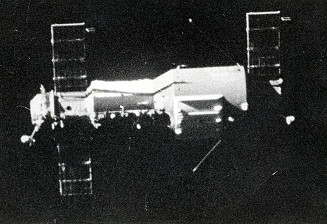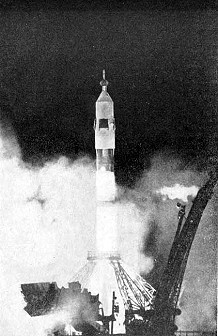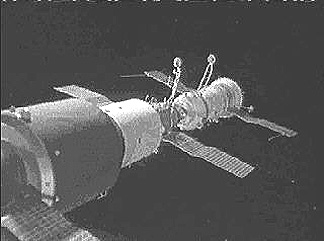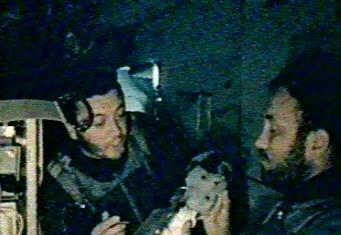While 1971 saw little to no visible activity from the Soviet Union’s Lunar Efforts, in the US, NASA was pressing on with their own Apollo Missions which were now entering the next stage.

The May of that year saw Apollo 15 begin the first J-Class Apollo Moon Mission, with the Lunar Surface stay time now extended to three days with the beefed-up LEM that could support the crew for the required time. Other notable differences between the J-Class and H-Class missions lay in that they ‘J’ missions would carry the Lunar Rover with them, permitting a greater travel capability for the crew on the Lunar Surface - although still required to be within “walk-back” distance of the LEM in case the Rover failed. Another significant difference lay in that the Geology Training that the astronauts received had been substantially revised, now being a high priority to maximise the science return value of each mission.

As a result, in the months leading up to Apollo 15, Dave Scott (Cmdr) and James Irwin (LMP), along with their backup crew, had undertaken field geology training at select geological sites in Arizona and New Mexico, becoming more realistic - with the addition of backpack mock-ups and communication via walkie-talkies to a CAPCOM nearby - as the launch date approached. While the CMP, Alfred Worden and his backup received a different training, learning to make and communicate their observations from a plane flying over terrain in a manner similar to how he’d see it from the CSM while it remained in Lunar Orbit.
Following their landing in the Hadley Rille, unlike the previous Lunar landings when the crew exited their LEM shortly after landing, the Apollo 15 crew had elected to remain in the LEM until the next day, the long duration of their EVAs (up to 7 hours) requiring that they be at their best. Although Dave Scott had become aware of the need to get an overview of the survey site prior to venturing outside. As a result, he successfully convinced the NASA management to allow a short “stand-up” EVA that would allow the people on the ground to get a general idea of what the site was really like to cut the chances of unexpected (nasty) surprises. For about 30 minutes, he described the area from his vantage point at the LEM docking hatch (with him standing on the Ascent Stage Engine Cover) before heading back inside the LEM and closing the hatch again. This had also aided to allay concerns about the use of the Rover, since prior observations had suggested that the area was covered in large boulders that would make traversing them impossible with it, Scott was able to see that there was nothing larger than 6-8 inches nearby, which would make using the Rover quite safe.

During the first sleep period, the most serious problem occurred, as the O2 supply dropped steadily, but faster than normal, indicating a leak from somewhere. With the LEM running in a low-power mode while the crew slept, they could not tell the precise cause until the crew was awoken an hour early and the high rate data telemetry stream was turned back on that they were able to trace the fault to a valve in the Urine Transfer Device was still open despite the receptacle being capped. Thankfully, less than 10% of the O2 supply was lost, with 50% of the O2 being reserve allowing the mission to continue as normal.

After collecting a contingency sample of lunar rock from around the LEM, the next step was to deploy the Lunar Rover, which had been stored on the side of the LEM descent stage, following which a test drive around the LEM was conducted by Scott, and other than the steering (which only worked on the back wheels instead of both the front and back wheels) and difficulty bending in their suits, it worked well.
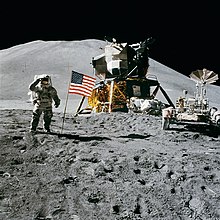
In order to make certain that they could get the most possible from their EVA, they first travelled to the most distant point of the traverse, and work their way back to the LEM, heading to the “Elbow” crater, which would also allow them to work out the precise location of where they landed, thanks to the Rover‘s navigation system that worked out the distance and direction of a known starting point.
The other location for the first EVA was the St George crater, and then a return to the LEM to set up the ALSEP consisting of a passive seismic experiment, lunar dust measurements and heat flow gauges drilled into the ground to name a few, taking the first EVA duration to 6.5 hours, and leaving Irwin dehydrated since his water bags in his suit hadn’t worked, and he went for over 7 hours without liquids.
The next two EVAs saw them travel to other distinct locations around the Hadley Rille, including the Dune crater at the South Cluster, the Spur crater, and Scarp crater. Amongst their tasks were to take a Deep Core Sample, though this proved to be a particular challenge, since the drill became stuck as they tried to pull it out, and they had to wait until their third EVA before they could finally obtain it.

But perhaps the most important find came during their second EVA, when they found a particular sample that was almost pure plagioclase, anorthosite, he new geology training they‘d received paid off as they found one of the oldest samples of lunar material, later found to date from the Lunar Pre-Imbrian Era - although they had initially believed that it came from the primordial crust of the Moon.
The mission, while achieving all of its key objectives, was overshadowed somewhat, by the revelation that the crew had carried with them (and without authorisation) postage stamps that they had intended to sell upon their return. The negative publicity ensured that it would be their last spaceflight.
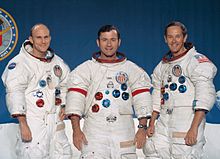
The following November would see John Young (Cmdr), Ken Mattingly (CMP), and Charles Duke (LMP) taken to the Descartes Highlands, where it was believed that the Descartes and Cayley formations in the area had been formed by magma more viscous than at the lunar maria, and likely by lunar volcanism.
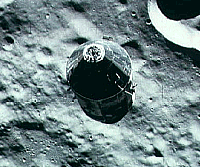
Despite issues with the CSM (chiefly with the backup control system for its steerable engine) that caused a significant delay in their landing (thereby requiring modification of their EVA activities to compensate), they were able to landing within 200 metres of their targeted landing site. Once they’d completed their first rest period on the Moon, they exited their LEM Cabin for their first Lunar EVA, beginning the preparatory work before they would begin their surface operations proper. Again, the Rover was deployed with ease, but unlike the Apollo 15 rover, this time it was the rear wheels that didn’t work for a time - although needing only one set of wheels to turn meant they could still use it. Spending just over 7 hours outside the LEM, they first planted the Flag of the USA, then set up the experiments package that would continue to operate after the crew had left, before travelling on the rover to Plum crater, at the edge of Flag crater for their first geologic stop. After which they went to Buster crater, where the largest single rock sample of the Apollo missions to that point (by mass) was collected, and a magnetic field experiment was set up.

The following two EVAs, over the next two days, they visited a number of sites of interest including, the Cinco craters, where at 152 metres above the LEM, was the highest elevation above a LEM for the Apollo missions, along with a number of other points along the North and South Ray craters. One particular detail they determined during their EVAs was that the disproving of the pre-mission volcanic hypothesis, owing to the large number of micrometeorite impacts found on a particularly large boulder dubbed “House Rock”. “Shadow Rock” was another interesting item that allowed them to obtain samples of permanently shadowed lunar regolith. They were also able to set a speed record of 10.6 mph on the Moon during their third and final EVA.

Their mission didn’t end with the return to the CSM. Before leaving, they deployed a sub-satellite (which Apollo 15 had also done the previous year) that would continue to observe the Moon when they left, although since a burn to place the CSM into the desired Lunar Orbit for the satellite had been cancelled, it would only last for half its originally intended lifetime before crashing into the Lunar Surface. Indeed, the orbit of PFS-2 kept changing wildly in both shape and altitude throughout its short 35-day duration. And again, like Apollo 15 before it, on the Trans-Earth Return, a deep-space EVA was conducted to retrieve the film cassettes from the SM before it would be jettisoned.

The May of that year saw Apollo 15 begin the first J-Class Apollo Moon Mission, with the Lunar Surface stay time now extended to three days with the beefed-up LEM that could support the crew for the required time. Other notable differences between the J-Class and H-Class missions lay in that they ‘J’ missions would carry the Lunar Rover with them, permitting a greater travel capability for the crew on the Lunar Surface - although still required to be within “walk-back” distance of the LEM in case the Rover failed. Another significant difference lay in that the Geology Training that the astronauts received had been substantially revised, now being a high priority to maximise the science return value of each mission.
As a result, in the months leading up to Apollo 15, Dave Scott (Cmdr) and James Irwin (LMP), along with their backup crew, had undertaken field geology training at select geological sites in Arizona and New Mexico, becoming more realistic - with the addition of backpack mock-ups and communication via walkie-talkies to a CAPCOM nearby - as the launch date approached. While the CMP, Alfred Worden and his backup received a different training, learning to make and communicate their observations from a plane flying over terrain in a manner similar to how he’d see it from the CSM while it remained in Lunar Orbit.
Following their landing in the Hadley Rille, unlike the previous Lunar landings when the crew exited their LEM shortly after landing, the Apollo 15 crew had elected to remain in the LEM until the next day, the long duration of their EVAs (up to 7 hours) requiring that they be at their best. Although Dave Scott had become aware of the need to get an overview of the survey site prior to venturing outside. As a result, he successfully convinced the NASA management to allow a short “stand-up” EVA that would allow the people on the ground to get a general idea of what the site was really like to cut the chances of unexpected (nasty) surprises. For about 30 minutes, he described the area from his vantage point at the LEM docking hatch (with him standing on the Ascent Stage Engine Cover) before heading back inside the LEM and closing the hatch again. This had also aided to allay concerns about the use of the Rover, since prior observations had suggested that the area was covered in large boulders that would make traversing them impossible with it, Scott was able to see that there was nothing larger than 6-8 inches nearby, which would make using the Rover quite safe.
During the first sleep period, the most serious problem occurred, as the O2 supply dropped steadily, but faster than normal, indicating a leak from somewhere. With the LEM running in a low-power mode while the crew slept, they could not tell the precise cause until the crew was awoken an hour early and the high rate data telemetry stream was turned back on that they were able to trace the fault to a valve in the Urine Transfer Device was still open despite the receptacle being capped. Thankfully, less than 10% of the O2 supply was lost, with 50% of the O2 being reserve allowing the mission to continue as normal.
After collecting a contingency sample of lunar rock from around the LEM, the next step was to deploy the Lunar Rover, which had been stored on the side of the LEM descent stage, following which a test drive around the LEM was conducted by Scott, and other than the steering (which only worked on the back wheels instead of both the front and back wheels) and difficulty bending in their suits, it worked well.

In order to make certain that they could get the most possible from their EVA, they first travelled to the most distant point of the traverse, and work their way back to the LEM, heading to the “Elbow” crater, which would also allow them to work out the precise location of where they landed, thanks to the Rover‘s navigation system that worked out the distance and direction of a known starting point.
The other location for the first EVA was the St George crater, and then a return to the LEM to set up the ALSEP consisting of a passive seismic experiment, lunar dust measurements and heat flow gauges drilled into the ground to name a few, taking the first EVA duration to 6.5 hours, and leaving Irwin dehydrated since his water bags in his suit hadn’t worked, and he went for over 7 hours without liquids.
The next two EVAs saw them travel to other distinct locations around the Hadley Rille, including the Dune crater at the South Cluster, the Spur crater, and Scarp crater. Amongst their tasks were to take a Deep Core Sample, though this proved to be a particular challenge, since the drill became stuck as they tried to pull it out, and they had to wait until their third EVA before they could finally obtain it.
But perhaps the most important find came during their second EVA, when they found a particular sample that was almost pure plagioclase, anorthosite, he new geology training they‘d received paid off as they found one of the oldest samples of lunar material, later found to date from the Lunar Pre-Imbrian Era - although they had initially believed that it came from the primordial crust of the Moon.
The mission, while achieving all of its key objectives, was overshadowed somewhat, by the revelation that the crew had carried with them (and without authorisation) postage stamps that they had intended to sell upon their return. The negative publicity ensured that it would be their last spaceflight.

The following November would see John Young (Cmdr), Ken Mattingly (CMP), and Charles Duke (LMP) taken to the Descartes Highlands, where it was believed that the Descartes and Cayley formations in the area had been formed by magma more viscous than at the lunar maria, and likely by lunar volcanism.

Despite issues with the CSM (chiefly with the backup control system for its steerable engine) that caused a significant delay in their landing (thereby requiring modification of their EVA activities to compensate), they were able to landing within 200 metres of their targeted landing site. Once they’d completed their first rest period on the Moon, they exited their LEM Cabin for their first Lunar EVA, beginning the preparatory work before they would begin their surface operations proper. Again, the Rover was deployed with ease, but unlike the Apollo 15 rover, this time it was the rear wheels that didn’t work for a time - although needing only one set of wheels to turn meant they could still use it. Spending just over 7 hours outside the LEM, they first planted the Flag of the USA, then set up the experiments package that would continue to operate after the crew had left, before travelling on the rover to Plum crater, at the edge of Flag crater for their first geologic stop. After which they went to Buster crater, where the largest single rock sample of the Apollo missions to that point (by mass) was collected, and a magnetic field experiment was set up.
The following two EVAs, over the next two days, they visited a number of sites of interest including, the Cinco craters, where at 152 metres above the LEM, was the highest elevation above a LEM for the Apollo missions, along with a number of other points along the North and South Ray craters. One particular detail they determined during their EVAs was that the disproving of the pre-mission volcanic hypothesis, owing to the large number of micrometeorite impacts found on a particularly large boulder dubbed “House Rock”. “Shadow Rock” was another interesting item that allowed them to obtain samples of permanently shadowed lunar regolith. They were also able to set a speed record of 10.6 mph on the Moon during their third and final EVA.
Their mission didn’t end with the return to the CSM. Before leaving, they deployed a sub-satellite (which Apollo 15 had also done the previous year) that would continue to observe the Moon when they left, although since a burn to place the CSM into the desired Lunar Orbit for the satellite had been cancelled, it would only last for half its originally intended lifetime before crashing into the Lunar Surface. Indeed, the orbit of PFS-2 kept changing wildly in both shape and altitude throughout its short 35-day duration. And again, like Apollo 15 before it, on the Trans-Earth Return, a deep-space EVA was conducted to retrieve the film cassettes from the SM before it would be jettisoned.
